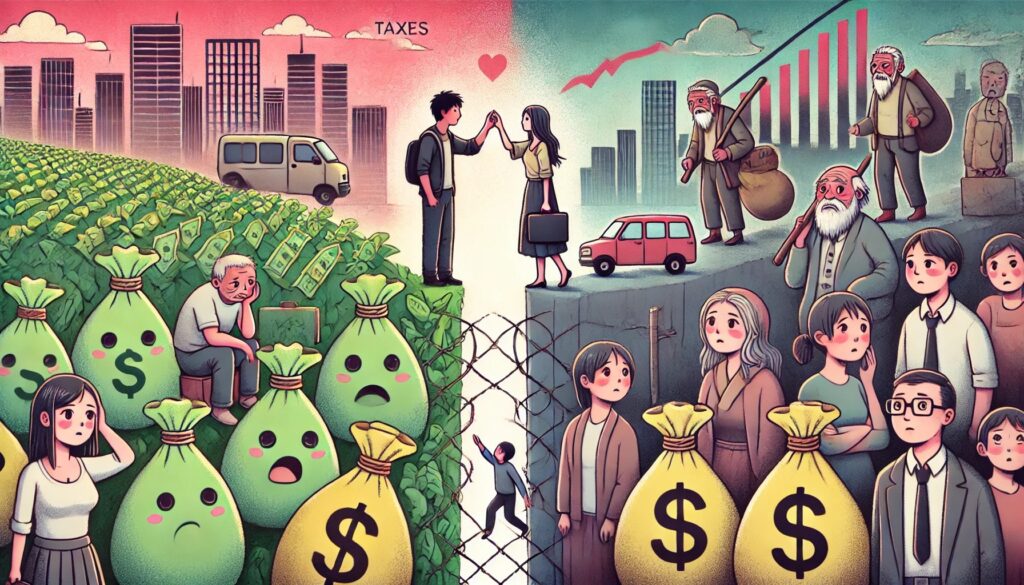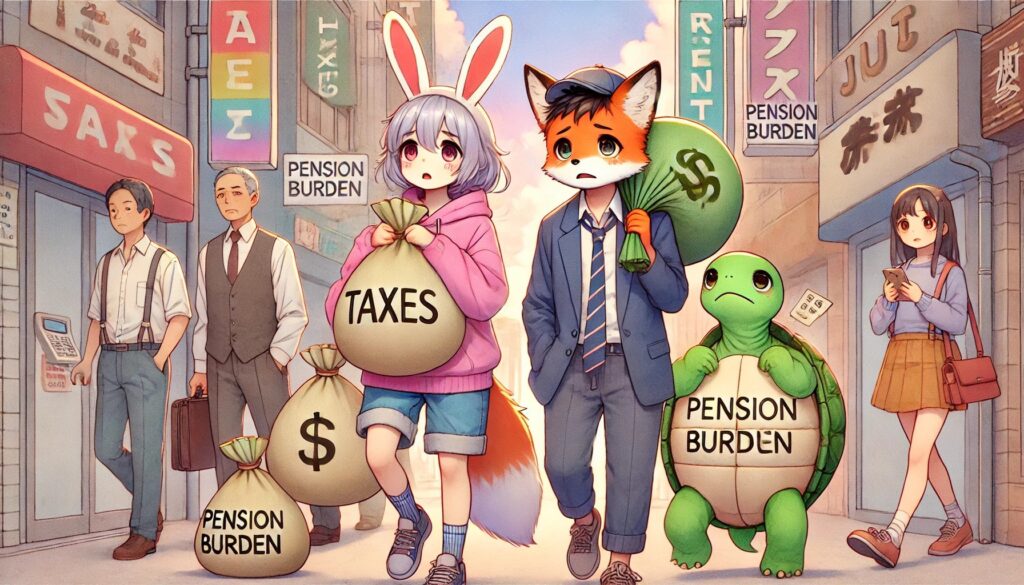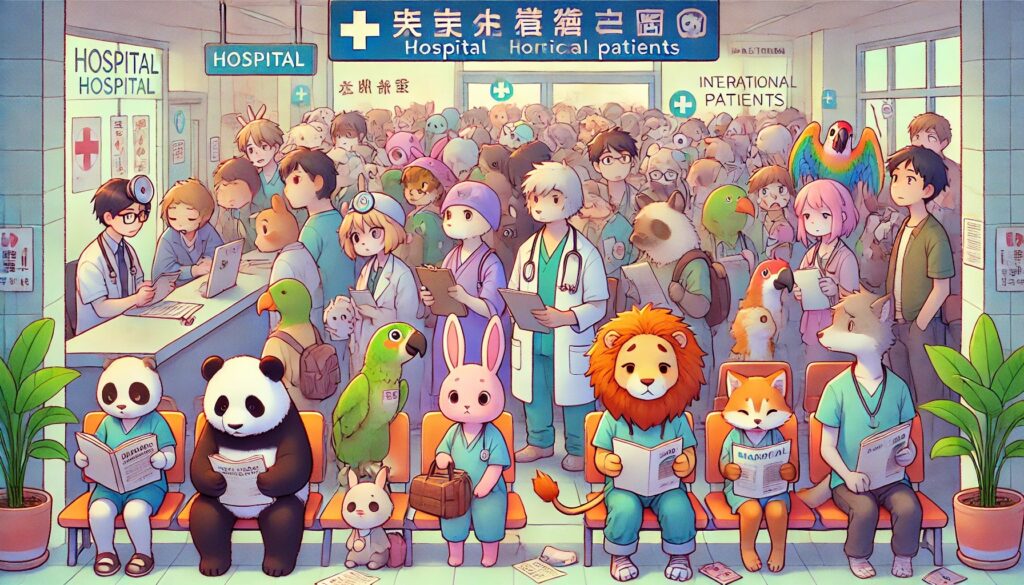In recent years, Japan’s marriage rate has significantly declined, and many young people have given up on marriage. “Unwilling singleness” refers to individuals who genuinely want to get married but are unable to due to economic and societal factors. This is not merely a shift in lifestyle preferences but a deep-rooted social structural problem.
Economic Burden on Young People
In Japan, the increase in non-regular employment, rising housing costs, and the growing burden of social security have significantly restricted the economic freedom of young people. As a result, many find it difficult not only to get married but even to live independently, further accelerating the decline in marriage rates.
Bride Shortage and Surplus
In rural areas, the migration of young women to cities has led to a “bride shortage,” while in urban areas, the opposite phenomenon of a “bride surplus” can be observed. However, despite more opportunities to meet people in cities, many young individuals postpone marriage, believing they still have time, only to miss their ideal marriage window.
Stagnant Growth Increasing Unmarried Rates
This issue is not unique to Japan; it is also severe in South Korea and China. South Korea’s birth rate has dropped to 0.72, and in China, the youth unemployment rate has exceeded 20%, creating economic instability that makes marriage more difficult. Meanwhile, countries like France and Sweden have implemented family support policies and tax incentives to encourage marriage, showing some positive effects.
Are the Elderly Burdening the Young?
In Japan, the increasing burden of social security continues to strain young people. With an aging population, the cost of medical care and pensions is rising, placing a heavier financial burden on the working generation. In particular, nearly 40% of medical expenses for the elderly are spent on “end-of-life care,” yet political ties with medical associations have hindered meaningful reform in the healthcare system.
Shifting from Elderly Benefits to Youth Support
Revising the elderly’s medical cost burden and strengthening economic support for young people is essential to creating a sustainable society. Policies such as tax exemptions for people in their 20s and more flexible pension systems should be considered to prioritize young people’s well-being.
Fraudulent Use of Social Security by Foreigners
The fraudulent use of Japan’s social security system by foreigners has become a growing concern. In the future, similar abuses in end-of-life care and elderly nursing may also become issues. Some hospitals, including those operated by foreign investors, may not be adequately monitored, leading to potential exploitation of the system.
This video explores the economic and social structures contributing to unwilling singleness and discusses the necessary policy measures Japan should implement to address the issue.
- Economic Burden on Young People
- Bride Shortage and Surplus
- Stagnant Growth Increasing Unmarried Rates
- Are the Elderly Burdening the Young?
- Shifting from Elderly Benefits to Youth Support
- Fraudulent Use of Social Security by Foreigners
- What is Unwilling Singleness?
- Political Ties with Medical Associations
- Solutions to Address Unwilling Singleness
What is Unwilling Singleness?
The term “Unwilling Singleness” was coined by columnist Kazuhisa Arakawa, referring to individuals who wish to get married but are prevented from doing so by economic and societal constraints. This phenomenon has gained increasing attention as a major factor behind Japan’s declining marriage rate.
This issue cannot be dismissed as merely a shift in lifestyle choices; it represents a fundamental societal problem. While the number of people who do not wish to get married has not dramatically increased, the number of those who want to but cannot has risen significantly.
As Japan’s marriage rate continues to decline, a trend of glorifying the “single lifestyle” has emerged. This could lead to a self-justification narrative where those who have given up on marriage try to rationalize their situation.
Of course, marriage is not the ultimate goal for everyone, and many people find happiness in being single. However, if individuals genuinely want to get married but feel financially incapable, this is not merely a personal choice but a decision forced upon them by society—it is truly an “unwilling” situation.
The Current State of Young People and Marriage
In the past, it was common to assume that marriage would naturally happen with age, but that is no longer the case. The decline in marriage rates is not just due to changing values but is largely influenced by economic factors.
Many young people today face unstable employment and struggle to secure regular jobs. The rise in non-regular employment and the increasing cost of living make even independent living difficult, let alone marriage. Additionally, marriage involves significant initial costs, such as wedding expenses, new housing, and child-rearing preparations, which place a heavy financial burden on young people.
Many young individuals rely on gig jobs or commission-based work for their livelihood, making marriage a distant dream due to financial instability.
Balancing work and family life is another challenge. Women, in particular, face significant burdens related to child-rearing and household responsibilities, making it difficult to maintain a career after marriage.
Regional and Urban Disparities
As Arakawa noted, young women tend to migrate from rural areas to cities, leading to a “bride shortage” in rural areas and a “bride surplus” in urban centers.
In cities, career-oriented women may postpone marriage, while the abundance of dating options can create a false sense of security, causing them to miss their ideal marriage window.
Many women mistakenly believe that attractiveness is tied to youth indefinitely. Some assume that they can find partners easily in their 30s, only to face harsh realities when they start serious matchmaking.
Online dating apps show stark differences between urban and rural areas. In cities, users can browse numerous profiles and select partners, whereas in rural areas, dating opportunities are extremely limited, creating a “romantic disparity.”
The Challenge of Marriage Beyond Japan
The decline in marriage rates and birth rates is not unique to Japan; similar trends are seen in South Korea and China.
South Korea has experienced a dramatic drop in marriage rates, with the birth rate hitting a world-low of 0.72 in 2023. High living costs in cities like Seoul make marriage and even independent living difficult. Additionally, the increasing emphasis on higher education and career advancement has led to later marriages and delayed childbearing.
In China, youth unemployment has exceeded 20%, creating significant economic uncertainty. Furthermore, the one-child policy has caused a gender imbalance, making it harder for men to find marriage partners. The rapid urbanization and evolving social expectations have also contributed to declining marriage rates.
In many Asian countries, marriage is increasingly becoming a privilege for those who are financially secure.
Solutions from Western Countries
Many Western nations have introduced policies to support marriage and family life.
For example, France provides substantial family allowances and economic assistance for childbirth and child-rearing. With a rise in dual-income households, policies have been implemented to allow both men and women to take parental leave.
Sweden offers free or low-cost childcare services, reducing the burden on working parents and making it easier for couples to balance careers and family life.
The U.S. and the U.K. provide flexible work environments where full-time and freelance jobs coexist, allowing young people to establish their careers earlier, reducing barriers to marriage and family life.
Addressing the Root of Young People’s Poverty
While Western countries have found some success, many nations, including Japan, continue to struggle with youth poverty.
The rise in non-regular employment means that approximately 40% of workers in Japan do not have stable income sources. Similar trends are observed in South Korea and China, where securing full-time employment has become increasingly difficult.
Additionally, while prices continue to rise, salaries have stagnated. With increasing tax burdens on the working population, young people’s disposable income continues to decline.
The Need for Political Reform
The core issue lies not in the aging population itself but in the way society is structured around elderly care and end-of-life medical treatments.
Japan’s annual medical expenses exceed 50 trillion yen, and caregiving costs are expected to reach 25 trillion yen by 2040. Nearly 40% of elderly medical expenses are spent on end-of-life care.
Political decisions are needed to ensure fairness between generations. Without reform, the burden will continue to fall on the younger generation, further discouraging marriage and family formation.
Political Ties with Medical Associations
The core issue of the high maintenance cost associated with the elderly is not just their numbers, but the societal structure that turns aging into a business.
According to 2023 data, Japan’s annual medical expenses amount to approximately 50 trillion yen.Caregiving costs are also rising, and they are expected to reach about 25 trillion yen by 2040.Additionally, approximately 40% of elderly medical expenses are spent on ‘end-of-life care.’
Among them, special nursing homes and caregiving facilities report that over 70% of operators face a severe labor shortage.It is a low-wage, physically demanding job that requires caregivers to handle demanding elderly patients, making it an extremely challenging profession.
In this way, the current societal approach of ‘prolonging life at all costs’ and ‘excessive caregiving’ continues to increase the burden on the working generation.In particular, Japan faces increasing medical and social security costs. However, the strong ties between the Japan Medical Association and the ruling party prevent necessary healthcare reforms from progressing.
For example, raising the elderly’s medical burden rate to the same 30% as the working generation and increasing it to 50% for end-of-life care could reduce social insurance premiums.
Additionally, since a cap is set on high medical expenses, long-term hospitalization can be covered by pensions. As a result, hospitalization in a terminal care hospital imposes less burden on families than home care. This situation may be one of the factors encouraging life-prolonging treatments.
In this way, unnecessary life-prolonging treatments continue to be carried out to protect the interests of the medical industry, placing the burden on the younger generation. This fundamental structure must be changed.
Abuse of Social Insurance by Foreigners
The abuse of Japan’s social insurance system by foreigners has become a major concern. In 2018, it was reported that within six months of arriving in Japan, 1,597 foreigners received high-cost medical treatments exceeding 800,000 yen in a single year. While not all cases were fraudulent, many may have come specifically to take advantage of Japan’s healthcare system.
Elderly care and end-of-life medical services could also be exploited in similar ways within Japan’s healthcare system. In particular, some cases in foreign-owned hospitals have not been reported, and there is a possibility that loopholes in the system are being exploited.
Political action is necessary, but the strong ties with the medical association remain a major obstacle. Unless this structure changes, the future for Japan’s younger generation will remain difficult.
Solutions to Address Unwilling Singleness
The cost of elderly care is not something that should be blamed on the elderly themselves. However, to prevent intergenerational strain, it is important for healthy seniors to contribute by working as long as they are able. Starting new businesses after retirement or supporting the younger generation could provide them with a renewed sense of purpose.
Moreover, avoiding unnecessary life-prolonging treatments and accepting a natural end should be considered a part of human dignity. This is also something that families must come to terms with.
At the very least, I would like to avoid spending a long period bedridden and reaching the end of life through life-prolonging treatment. Additionally, maintaining personal dignity while receiving daily support in a nursing facility is an important issue to consider.
Of course, if life-prolonging treatments are a personal luxury for the wealthy, they should be free to pursue them with their own funds. However, such costly measures should not be widely implemented through social security systems.
Investing in the Future Generation
Marriage difficulties are not simply due to changing values but are a result of economic and social constraints. Bold policies, such as tax exemptions for young people and revised pension structures, are necessary.
Investing in the younger generation will yield long-term economic benefits, ensuring a more stable and prosperous society for future generations.









